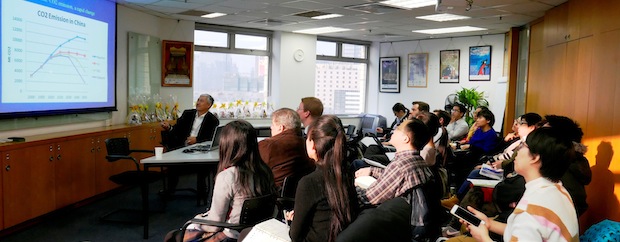
November 2016 - Early in 2016, China’s National Development and Reform Commission (NDRC) announced to integrate the building sector and the steel industry, among other things, into the Chinese national emissions trading scheme (EHS) from 2017 onwards. As the world’s largest producer of steel and cement, China faces the important task of further reducing the energy consumption and emissions of these traditional industries, while at the same time lowering existing overcapacity.
Against this backdrop, the AHK Greater China Beijing, on behalf of the German Federal Ministry for the Environment, Nature Conservation, Building and Nuclear Safety (BMUB), invited business representatives and experts to a network meeting held on November 24th. Two speakers gave presentations on emissions and developments within the Chinese building sector with special focus on the steel and cement industry.
The network meeting began with a presentation by Prof. Jiang Kejun presenting his forecasts for the cement and steel industry. He expects the production capacities to decline from 2030 onwards, since 55 per cent of the cement produced in China and 65 per cent of the steel production are used in the building sector and the potentially buildable areas will decrease in the future. The speaker also predicted a similar trend for CO2 emissions in the cement and steel sector. Prof. Jiang Kejun also argued for the increased implementation of Carbon Capture and Storage (CCS) in the building sector, which has received only little financial support until now.
The second speaker, Shi Lijie from the International Cooperation Department of the China National Building Materials Group Corporation (CNBM), gave insights into the experiences and measures for a low-carbon development in the building sector from a company perspective. With regard to the carbon market, CNBM sees the ETS as an opportunity to accelerate technological innovation as well as a solution to challenging overcapacity in the building sector. CNBM is an active participant in the carbon market and has already initiated several projects within the framework of the Clean Development Mechanism (CDM). Since 2016, the company has also been accredited as an independent authority for the verification of CO2 emissions in China.
An in-depth report on the network meeting is contained in the November issue of the Econet Monitor magazine published by the environmental experts at the AHK Greater China in Beijing. The article is also available for download online.
Note: The publication is available only in German.
Cookie Settings
Marketing-Cookies werden von Drittanbietern oder Publishern verwendet, um personalisierte Werbung anzuzeigen. Sie tun dies, indem sie Besucher über Websites hinweg verfolgen.
Provider:
Statistik Cookies
Statistik-Cookies dienen der Analyse und helfen uns dabei zu verstehen, wie Besucher mit unserer Website interagieren, indem Informationen anonymisiert gesammelt werden. Auf Basis dieser Informationen können wir unsere Website für Sie weiter verbessern und optimieren.
Provider:
Erforderliche Cookies
Erforderliche Cookies sind für den reibungslosen Betrieb der Website zuständig, indem sie Kernfunktionalitäten ermöglichen, ohne die unsere Website nicht richtig funktioniert. Diese Cookies können nur über Ihre Browser-Einstellungen deaktiviert werden.
Provider: